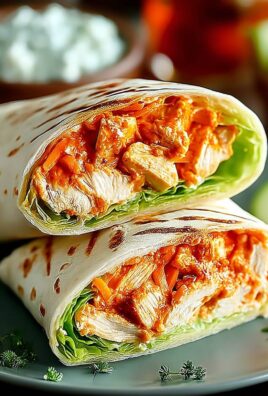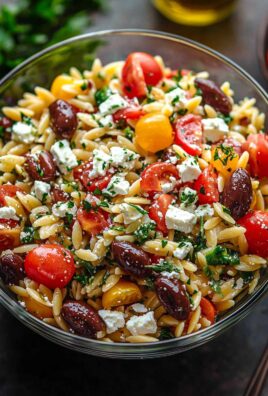Easy Korean Rabokki, a delightful fusion of Korean ramen and tteokbokki, is about to become your new favorite comfort food! Imagine this: chewy rice cakes swimming in a vibrant, spicy-sweet gochujang sauce, perfectly complemented by springy ramen noodles. Are you drooling yet? I know I am just thinking about it!
Rabokki, a popular Korean street food, emerged as a creative way to elevate the classic tteokbokki. Tteokbokki itself boasts a rich history, evolving from a royal court dish to a beloved everyday snack. The addition of ramen noodles transformed it into a heartier, more satisfying meal, quickly gaining popularity among students and busy individuals seeking a quick and delicious bite.
What makes easy Korean Rabokki so irresistible? It’s the perfect balance of flavors and textures. The spicy kick of the gochujang is tempered by a subtle sweetness, while the chewy rice cakes and springy ramen create a textural symphony in your mouth. Plus, it’s incredibly customizable! Add your favorite vegetables, protein, or even cheese for a personalized culinary experience. This recipe is designed to be quick and easy, perfect for a weeknight dinner or a weekend treat. Get ready to experience a taste of Korea that will leave you craving more!
Ingredients:
- For the Rabokki Sauce:
- 2 tablespoons gochujang (Korean chili paste)
- 1 tablespoon gochugaru (Korean chili powder)
- 2 tablespoons soy sauce
- 1 tablespoon sugar
- 1 tablespoon honey or corn syrup (for extra sweetness and shine)
- 1 tablespoon minced garlic
- 1 teaspoon sesame oil
- 1/2 cup water (adjust for desired consistency)
- For the Noodles:
- 2 packs of instant ramen noodles (Shin Ramyun or similar spicy ramen recommended)
- 400g Korean rice cakes (tteokbokki), cylindrical or sliced
- For the Add-ins (Optional, but highly recommended!):
- 2 hard-boiled eggs, peeled and halved
- 2 green onions, chopped
- 1/2 cup fish cakes (eomuk), sliced
- 1/2 cup cabbage, chopped
- 1/4 cup enoki mushrooms
- 2 slices of American cheese (trust me on this one!)
- Spam or sausage, sliced (optional, for extra protein)
Preparing the Rabokki Sauce:
Okay, let’s get started with the heart of our rabokki the sauce! This is where all the magic happens, and it’s surprisingly easy to whip up.
- In a medium bowl, combine the gochujang, gochugaru, soy sauce, sugar, honey (or corn syrup), minced garlic, and sesame oil.
- Mix everything together really well until you have a smooth, vibrant red paste. Don’t be afraid to get in there with a spoon and make sure there are no clumps of gochujang.
- Now, slowly add the water, stirring continuously. You want to achieve a sauce that’s thick enough to coat the noodles and rice cakes, but not so thick that it’s difficult to stir. You can always add a little more water later if needed.
- Taste the sauce! This is crucial. Is it spicy enough for you? Does it need a little more sweetness? Adjust the gochugaru, sugar, or honey to your liking. Remember, you can always add more, but you can’t take it away!
- Set the sauce aside for now. The flavors will meld together even more as it sits, creating a richer, more complex taste.
Cooking the Rabokki:
Now for the fun part bringing it all together! This is where your kitchen will start to smell amazing, and your stomach will start to rumble.
- In a large, wide pot or skillet (a wok works great too!), add about 2 cups of water. You want enough water to cook the rice cakes and noodles, but not so much that it becomes a soup.
- Bring the water to a boil over medium-high heat.
- Once the water is boiling, add the Korean rice cakes (tteokbokki). Give them a good stir to prevent them from sticking to the bottom of the pot.
- Cook the rice cakes for about 5-7 minutes, or until they are soft and chewy. You should be able to easily pierce them with a fork. If they’re still hard, cook them for a few more minutes.
- Now, pour in the rabokki sauce that you prepared earlier. Stir well to coat the rice cakes evenly with the sauce.
- Add the fish cakes, cabbage, and any other vegetables you’re using (except the green onions and enoki mushrooms we’ll add those later). Stir everything together and let it simmer for a few minutes, allowing the flavors to meld.
- Carefully add the instant ramen noodles to the pot. You can break them in half if you prefer shorter noodles.
- Cook the noodles according to the package directions, usually about 3-4 minutes. Be careful not to overcook them, as they will become mushy. Stir occasionally to prevent them from sticking.
- As the noodles cook, they will absorb some of the sauce, so you may need to add a little more water if the mixture becomes too dry. You want a nice, saucy consistency.
- Once the noodles are cooked to your liking, add the hard-boiled eggs, sliced spam or sausage (if using), and enoki mushrooms. Stir gently to incorporate them into the rabokki.
- Reduce the heat to low and place the slices of American cheese on top of the rabokki. Cover the pot with a lid and let the cheese melt for about a minute or two. This is what gives it that creamy, gooey texture that’s so addictive!
- Remove the pot from the heat and garnish with the chopped green onions.
Serving and Enjoying Your Rabokki:
Congratulations! You’ve just made a delicious and satisfying bowl of rabokki. Now it’s time to dig in and enjoy!
- Carefully transfer the rabokki to bowls. Be sure to get a good mix of noodles, rice cakes, vegetables, and eggs in each bowl.
- Serve immediately while it’s hot and the cheese is still melted and gooey.
- You can add extra gochugaru or a drizzle of sesame oil on top for an extra kick of flavor.
- Rabokki is best enjoyed with a spoon and chopsticks. Use the chopsticks to grab the noodles and rice cakes, and the spoon to scoop up the sauce and other ingredients.
- Don’t be afraid to get messy! Rabokki is a dish that’s meant to be enjoyed with gusto.
- Leftovers can be stored in an airtight container in the refrigerator for up to 2 days. Reheat gently in a microwave or on the stovetop. You may need to add a little water to prevent it from drying out.
Tips and Variations:
Rabokki is a very versatile dish, and you can easily customize it to your liking. Here are a few ideas:
- Add more vegetables: Feel free to add other vegetables such as carrots, onions, zucchini, or bell peppers.
- Use different types of noodles: You can use udon noodles or glass noodles instead of ramen noodles.
- Make it vegetarian: Omit the fish cakes and spam, and use vegetable broth instead of water. You can also add tofu or tempeh for protein.
- Adjust the spice level: If you’re not a fan of spicy food, reduce the amount of gochujang and gochugaru. You can also add a dollop of sour cream or yogurt to cool it down.
- Add seafood: Shrimp, mussels, or squid would be delicious additions to rabokki.
- Experiment with different cheeses: Mozzarella, cheddar, or provolone would also work well in place of American cheese.
- Make it a one-pot meal: If you’re short on time, you can cook everything in one pot. Just add the ingredients in the order listed above, and adjust the cooking time as needed.
Enjoy your homemade Rabokki!

Conclusion:
This isn’t just another recipe; it’s a culinary adventure waiting to happen! I truly believe this Easy Korean Rabokki is a must-try for anyone craving a flavorful, satisfying, and incredibly fun meal. The perfect balance of sweet, spicy, and savory, combined with the delightful chewiness of the ramen and tteokbokki, creates a symphony of textures and tastes that will leave you wanting more. It’s quick enough for a weeknight dinner, yet impressive enough to serve to friends. Trust me, once you try this, it will become a regular in your rotation.
But the best part? It’s incredibly versatile! Feel free to customize it to your liking. For a heartier meal, add some boiled eggs, fish cakes (odeng), or even some mandu (Korean dumplings). If you’re feeling extra adventurous, try incorporating some kimchi for an added layer of fermented goodness and a touch more tang. Vegetarians can easily substitute the fish cakes with extra vegetables like mushrooms, spinach, or bok choy. And for those who prefer a milder spice level, simply reduce the amount of gochujang or gochugaru. You can even add a dollop of cream cheese at the end for a richer, creamier sauce. The possibilities are endless!
Serving suggestions? I love to enjoy my rabokki straight from the pot, family-style, with a side of danmuji (yellow pickled radish) for a refreshing contrast. It’s also fantastic served with a sprinkle of sesame seeds and a drizzle of sesame oil for added aroma and flavor. And if you have any leftovers (though I highly doubt you will!), they’re just as delicious the next day.
I’ve poured my heart into perfecting this recipe, and I’m confident that you’ll love it as much as I do. It’s a guaranteed crowd-pleaser, perfect for sharing with loved ones or enjoying as a comforting solo meal. The beauty of this Easy Korean Rabokki lies not only in its deliciousness but also in its simplicity. It’s a dish that anyone can master, regardless of their cooking experience.
So, what are you waiting for? Gather your ingredients, put on your favorite K-pop playlist, and get ready to embark on a culinary journey to Korea! I’m so excited for you to try this recipe and experience the magic of rabokki for yourself.
And most importantly, I want to hear about your experience! Did you make any modifications? What did you think of the spice level? What were your favorite additions? Please, please, please share your photos and stories in the comments below. I can’t wait to see your creations and hear your feedback. Your insights will not only help me improve the recipe but also inspire other readers to try it out. Let’s build a community of rabokki lovers together! Happy cooking!
Easy Korean Rabokki: The Ultimate Guide to Making It at Home
Spicy and savory Korean Rabokki featuring ramen noodles and chewy rice cakes in a fiery gochujang sauce. Customize with your favorite toppings for a satisfying meal.
Ingredients
- 2 tablespoons gochujang (Korean chili paste)
- 1 tablespoon gochugaru (Korean chili powder)
- 2 tablespoons soy sauce
- 1 tablespoon sugar
- 1 tablespoon honey or corn syrup (for extra sweetness and shine)
- 1 tablespoon minced garlic
- 1 teaspoon sesame oil
- 1/2 cup water (adjust for desired consistency)
- 2 packs of instant ramen noodles (Shin Ramyun or similar spicy ramen recommended)
- 400g Korean rice cakes (tteokbokki), cylindrical or sliced
- 2 hard-boiled eggs, peeled and halved
- 2 green onions, chopped
- 1/2 cup fish cakes (eomuk), sliced
- 1/2 cup cabbage, chopped
- 1/4 cup enoki mushrooms
- 2 slices of American cheese
- Spam or sausage, sliced (optional)
Instructions
- Prepare the Fruits: Wash, peel, and cut the pineapple into chunks. Peel and cube the mango. Peel, seed, and chunk the papaya. Scoop out the pulp from the passion fruits.
- Gather Liquids: Measure out the coconut water and freshly squeezed orange juice.
- Grate Ginger: Grate about a teaspoon of fresh ginger.
- Squeeze Lime: Squeeze the lime to extract about a tablespoon of fresh lime juice.
- Prepare Turmeric (Optional): Measure out about 1/2 teaspoon of turmeric powder. Remember to add a pinch of black pepper.
- Combine Ingredients in the Blender: Place all prepared ingredients into a high-powered blender.
- Add Ice (Optional): Add a handful of ice cubes to the blender.
- Blend Until Smooth: Secure the lid on the blender and blend on high speed until all the ingredients are completely smooth.
- Check the Consistency: Once the juice is blended, check the consistency.
- Taste and Adjust: Taste the juice and adjust the flavors as needed.
- Pour into Glasses: Pour the blended juice into glasses.
- Garnish (Optional): Garnish the glasses with a pineapple wedge, a mango slice, or a sprig of fresh mint.
- Serve Immediately: Serve the juice immediately for the best flavor and freshness.
- Storage (If Necessary): If you have any leftover juice, you can store it in an airtight container in the refrigerator for up to 24 hours.
- Enjoy!
Notes
- Don’t Overbake: Overbaking the sponge cake will make it dry and prone to cracking.
- Roll While Warm: Rolling the cake while it’s still warm helps it retain its shape and prevents it from cracking.
- Use Parchment Paper: Lining the jelly roll pan with parchment paper is essential for easy removal of the cake.
- Chill Before Slicing: Chilling the pionono before slicing makes it easier to cut clean slices and prevents the filling from squishing out.
- Get Creative with Fillings: Don’t be afraid to experiment with different fillings to find your favorite combination.
- Additional Filling Ideas (Beyond Tuna):
- Chicken Salad: Use shredded cooked chicken, mayonnaise, celery, grapes, and walnuts for a creamy and flavorful filling.
- Ham and Cheese: Spread with cream cheese and layer with thinly sliced ham and Swiss cheese.
- Spinach and Artichoke: Combine cooked spinach, artichoke hearts, cream cheese, Parmesan cheese, and garlic for a rich and savory filling.
- Smoked Salmon: Spread with cream cheese and layer with thinly sliced smoked salmon, capers, and red onion.
- Vegetarian: Hummus, roasted vegetables (like zucchini, eggplant, and bell peppers), and feta cheese make a delicious and healthy filling.





Leave a Comment